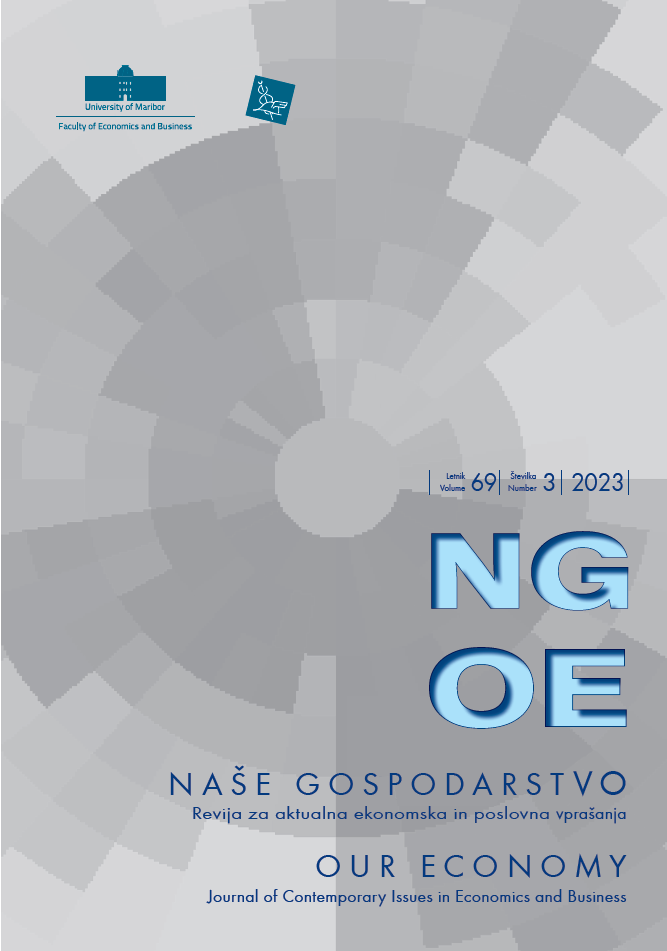Impacts of the 2022 War in Ukraine on the Travel Habits of Ukrainian Tourists
Keywords:
turizem, potovanja, potovalne navade, vojna, UkrajinaAbstract
The purpose of this paper is to explore how the travel habits of Ukrainian tourists changed after the beginning of the 2022 war in Ukraine in com- parison to the year 2021. The theoretical part of the paper discusses the impacts of war on tourism; in the empirical part, the secondary and the primary research on the Ukrainians’ travel habits before and during the war is performed. The research gives an insight into the frequency of travelling, planned spending on travel, ethnic dilemmas on travelling, and travel desti- nations. The research is essential in the context of war and post-war periods for understanding the psychological and behavioral effects, assessing economic consequences, addressing destination marketing and recovery efforts, and facilitating reconciliation and social integration. Research limi- tations include the scope and generalizability of the findings, self-reporting biases, causality and temporal issues, and limited timeframe and context.
Downloads
References
Barsukova, O. (2022). Podorozhi pid chas viyny: de pomeljeno vidpochyvaty i yak bezpechno orhanizuvaty mandrivku. Retrieved from https://life.pravda.com.ua/travel/2022/06/20/249177/.
Butler, R. & Suntikul, W. (2013). Tourism and war: an ill wind? In R. Butler & W. Suntikul (Eds.), Tourism and war (pp. 1–12). London: Routledge. DOI: https://doi.org/10.4324/9780203107706
Currie, D., Skare, M., & Loncar, J. (2004). The impact of war on tourism: the case of Croatia. In Conference on Tourism Economics, Palma de Mallorca, 28-29. May 2004 (pp. 1–14). Retrieved from https://www.researchgate.net/profile/Marinko-Skare/publication/228423759_The_impact_of_War_on_Tourism_the_case_of_Croatia/links/00b7d5228532ac12e0000000/The-impact-of-War-on-Tourism-the-case-of-Croatia.pdf.
DART. (2021). Provedennya doslidzhennya vnutrishn'oho ta vyyiznoho turyzmu ukrayintsiv. Kyiv: DART. Retrieved from https://drive.google.com/file/d/1VbzkC8sG9muJGJjEUCFkzBfAsIVbke9A/view
DART. (2022). DART oprilyudnyuie masshtabni turistichni doslidzhennya. Retrieved from https://www.tourism.gov.ua/blog/dart-oprilyud-nyuie-masshtabni-turistichni-doslidzhennya.
Hall, C. M., & Tucker, H. (2004). Tourism and the World's Regions: Understanding the New Global Geography. London: Routledge.
Liu, A., Pratt, S., & Lo, A. (2013). The impact of the Syrian conflict on Lebanese and Jordanian tourism. Current Issues in Tourism, 16(3), 287-303.
NTOU (2021). National Tourism Organization of Ukraine. Turystychnyy barometr Ukrayiny 2020. Kyiv: National Tourism Organization of Ukraine. Retrieved from https://www.ntoukraine.org/assets/files/ntou-statistics-barometer-2020.pdf.
Pellejero Martinez, C. (2020). Conclusions. In C. Pellejero Martinez & M. Luque Aranda (Eds.), Inter and Post-war Tourism in Western Europe, 1916–1960 (pp. 207–210). Cham: Palgrave Macmillan. DOI: https://doi.org/10.1007/978-3-030-39597-1
Pizam, A. & Mansfeld, Y. (2006). Toward a theory of tourism security. In Y. Mansfeld & A. Pizam (Eds.), Tourism, Security and Safety: From Theory to Practice (1st ed.) (pp. 1–29). New York: Routledge.
Ram, Y., & Gilboa, S. (2005). Destination image, self-congruity, and travel behavior: Toward an integrative model. Journal of Travel Research, 43(4), 340-352. DOI: 10.1177/004728750003800402
Ritchie, B. W. (2004). Chaos, crises, and disasters: A strategic approach to crisis management in the tourism industry. Tourism Management, 25(6), 669-683. DOI: 10.1016/j.tourman.2003.09.004
Timothy, D. J., & Boyd, S. W. (2003). Heritage tourism in the aftermath of conflict: The cases of Bosnia-Herzegovina and Cyprus. Journal of Travel Research, 42(4), 369-380.
Weaver, A. (2011). Tourism and the military: pleasure and the war economy. Annals of Tourism Research, 38(2), 672–689. DOI: https://doi.org/10.1016/j.annals.2010.12.005.
Downloads
Published
Issue
Section
License
Copyright (c) 2023 Vito Bobek, Gal Gotal, Tatjana Horvat

This work is licensed under a Creative Commons Attribution-NonCommercial-NoDerivatives 4.0 International License.
